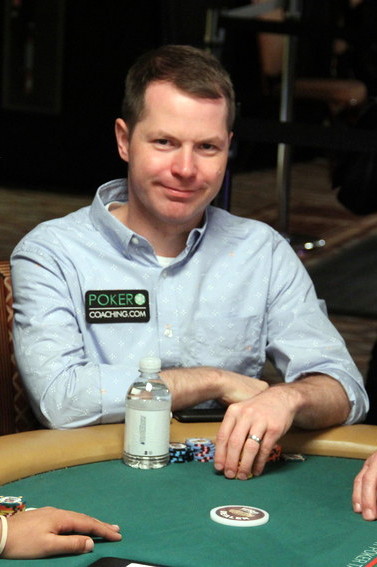[ad_1]
 If you want to increase your poker skills and learn to crush the games, check out Jonathan Little’s elite training site at PokerCoaching.com/CardPlayer.
If you want to increase your poker skills and learn to crush the games, check out Jonathan Little’s elite training site at PokerCoaching.com/CardPlayer.
In a recent $3,500 buy-in main event, I found myself in a tricky spot on the river that I would like to share with you.
My main opponent in this hand was a 50-year-old player who seemed to be somewhat loose and passive. He also seemed to overvalue most of his premium hands, which is a common trait most recreational players display.
With a 25,000 effective stack, my opponent limped from middle position at 100-200 with a 200 big blind ante.
I limped behind from the button with 9 5
5 . The small blind completed, and the big blind checked their option.
. The small blind completed, and the big blind checked their option.
With 9 5
5 , I am fine with all three options, limping, raising, and folding. I prefer limping because my hand is fairly weak, but still has a little bit of post-flop potential. More importantly though, I know that if I happen to flop a strong hand, my main opponent in the hand will likely call me down with all sorts of marginal hands.
, I am fine with all three options, limping, raising, and folding. I prefer limping because my hand is fairly weak, but still has a little bit of post-flop potential. More importantly though, I know that if I happen to flop a strong hand, my main opponent in the hand will likely call me down with all sorts of marginal hands.
If I thought my opponent would play in a weak, passive manner after the flop where he will fold to a continuation bet most of the time, I would have raised. If I thought he would play well, I would have folded.
The flop came Q 7
7 6
6 , giving me a flush draw and a gutshot straight draw. That is lucky!
, giving me a flush draw and a gutshot straight draw. That is lucky!
The blinds checked to the middle position player who bet 600 into the 1,000 pot.
Both calling and raising are acceptable options but I prefer raising. The stacks are fairly deep and I want to build a pot so that when I complete my draw, I can make a sizable bet and ideally get paid off for a lot of chips.
I raised to 1,600. The blinds folded and my opponent thought for a few seconds before calling. The turn was the 10 , a complete blank for me. My opponent quickly bet 600 into the 4,200 pot.
, a complete blank for me. My opponent quickly bet 600 into the 4,200 pot.
This small lead is a bet that most amateur players will make with a hand that is fairly strong, but non-premium. I assumed he had something like K-Q, 7-6, or perhaps even a set. I was unsure if he would fold if I raised, but I was fairly certain that if I raised on the turn and then bet large on the river that he would fold most of his one-pair hands, (making a river bluff extremely profitable). I also thought that if I raised the turn and bet small on the river that he would call (allowing me to get value from my nut hands).
I raised to 3,000, as I would also do with my premium made hands, such as 9-8 and 7-7. My opponent quickly called. The river was the 3 , another complete blank, and my opponent checked.
, another complete blank, and my opponent checked.
When you find yourself on the river with the bottom of your range, which will often be the case when you have a busted draw, it is usually a good idea to bluff, especially if you have lots of value hands in your range.
While most people would bet “large,” perhaps 8,000 into the 10,200 pot, hoping to make their opponent fold, I did not think this specific opponent would fold top pair or better to a “typical” large bet. In order to steal this pot, I needed to make a bet that my opponent could simply not justify calling.
So, I went all-in for 20,175, betting two times the size of the pot. My opponent thought for around three minutes, counting out the chips as if he was about to call. I remained stoic throughout the process. He eventually folded 10 7
7 , two pair, face up, giving me the pot.
, two pair, face up, giving me the pot.
What a relief, poker is fun! ♠
 Jonathan Little is a two-time WPT champion with more than $7 million in live tournament earnings, best-selling author of 15 educational poker books, and 2019 GPI Poker Personality of the Year. If you want to increase your poker skills and learn to crush the games, check out his training site at PokerCoaching.com/cardplayer.
Jonathan Little is a two-time WPT champion with more than $7 million in live tournament earnings, best-selling author of 15 educational poker books, and 2019 GPI Poker Personality of the Year. If you want to increase your poker skills and learn to crush the games, check out his training site at PokerCoaching.com/cardplayer.
[ad_2]
Source link